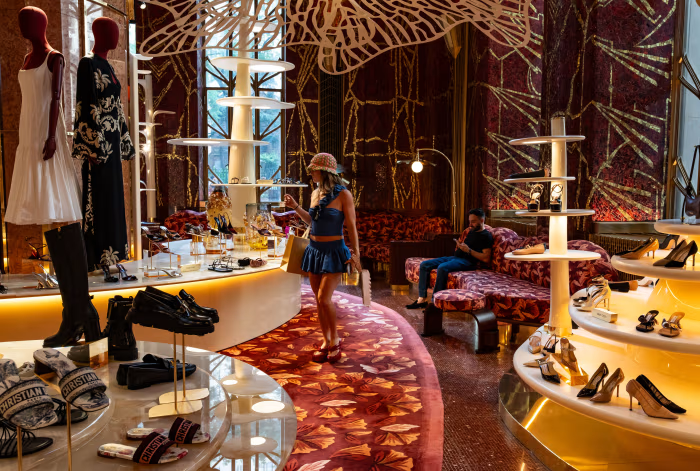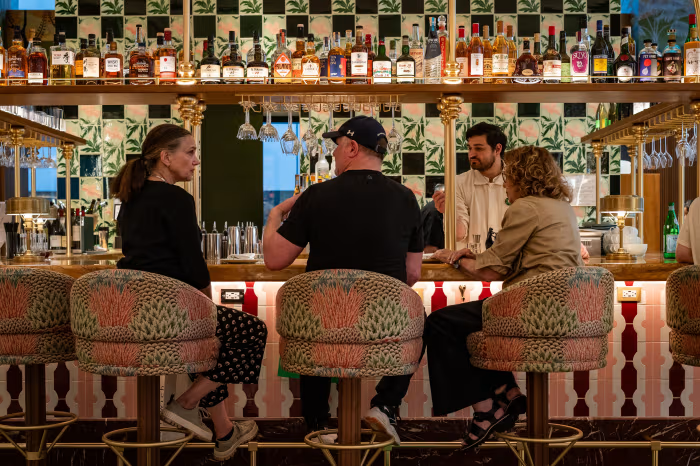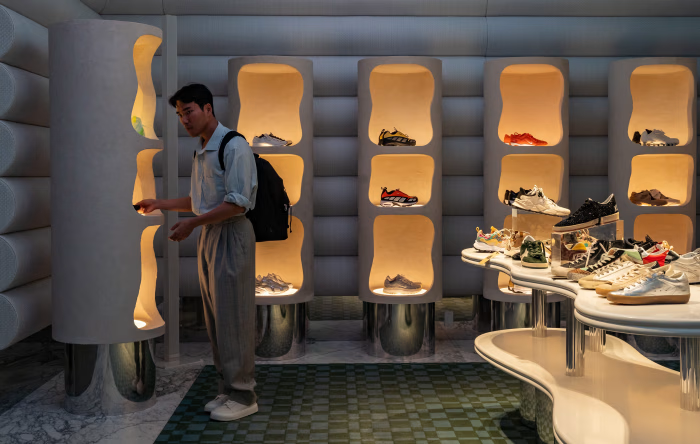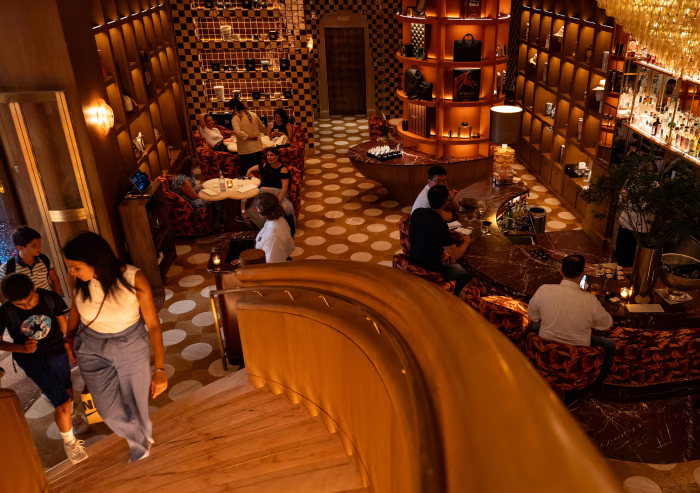Can the French Reinvent America’s Broken Department-Store Model?
- July 14, 2025
- International Market Knowledge

The Red Room (pictured above) at Printemps New York was built in 1931 and served as the reception area for the former Irving Trust bank.
Printemps New York is following the European department-store playbook of serving up enough to keep shoppers occupied far beyond the fitting room.
The American department-store model is broken. A French operator that recently opened a flagship store in New York City thinks it has a better one.
Printemps New York is following the European department-store playbook of serving up enough food and drinks, exhibitions and other activities to keep shoppers occupied far beyond the fitting room.
The store in Manhattan’s financial district was designed to evoke a luxurious Parisian residence. It more closely resembles a chic nightspot than it does a suburban Macy’s. The new store features an espresso cafe under a green-and-white circus tent, three other restaurants, hand-painted tiles, a champagne bar and spa chairs for mini-facials and head massages.
At 55,000 square feet, the New York store is less than half the size of a typical U.S. department store. It also has far less floor space dedicated to clothing racks and cosmetics counters.
“We said, ‘it’s going to be an apartment store, not a department store,’” Printemps Group Chief Executive Jean-Marc Bellaiche said.
It is too early to say whether Printemps’s museum-grade decor and its philosophy of combining dining, art and retail can win over American shoppers.
But the traditional U.S. department store model has been in decline for decades. After peaking at nearly $97 billion in 1999, the industry’s annual sales had fallen 69% by the end of 2023, according to the U.S. Census Bureau.


Earlier iterations of the American department store sold everything from car parts to toiletries, and were prized by mall owners for their ability to draw crowds of shoppers.
But competition from discount and specialty stores eroded department stores’ market share, forcing onetime giants like Sears into bankruptcy filings. Others, like Neiman Marcus and Saks Fifth Avenue, have merged to survive.
More than 1,000 department store locations have closed since 2016, according to real-estate analytics firm Green Street, with more closures on the way as Macy’s and others continue to downsize.
The growing trend of luxury brands bypassing department stores in favor of their own locations dealt an additional blow. Customer foot traffic to department stores has declined about 30% since the Covid-19 pandemic, according to Green Street.
European department stores have better weathered the rise of e-commerce and changing shopping habits. That is in part because the European model has always been diversified well beyond fashion, said Joëlle Grünberg, who leads consulting firm McKinsey’s apparel, fashion and luxury sector in North America.


In London and Paris, department stores offer haircuts, massages, art exhibitions, sit-down dining and entertainment. Le Bon Marché in the 7th arrondissement of Paris holds immersive plays on the department store’s floors after hours.
While rising costs have been a challenge in recent years, revenues at European department stores were up 10% in 2024 compared with five years prior, according to Green Street.
“A department store in Europe is a place where you can spend the whole day,” Grünberg said. “In the U.S., if I was asked to spend five hours in any given department store, whether it’s Macy’s or Bergdorf’s or anywhere else, I don’t know what I’d do all day.”
Printemps opened in Paris in 1865, and was an early adopter of innovations ranging from electric lighting to extensive menswear collections. The flagship location on Boulevard Haussman spans 484,000 square feet and contains 15 restaurants.
Another 18 stores are sprinkled across France. A previous American location, which opened in Denver in 1987 and lasted fewer than two years, was operated under a franchise agreement, according to Printemps.
Bellaiche declined to offer specifics, but said sales in New York since Printemps’s March opening have exceeded expectations. A quarter of its brands are either exclusive or new to the U.S., including French and European designers such as Joseph Duclos.
Shoppers—or simply the curious—waited in long lines to enter Printemps during its first weekend, and the store continues to attract crowds. On a recent Friday afternoon, it was buzzing with tourists in jean shorts and serious shoppers sporting designer brands. Upbeat French music piped through the speakers.
At the bottom of a pink marble staircase, a bar and restaurant sit outside the historic Red Room, which was built in 1931 and served as the reception area for the former Irving Trust bank.
Tiled floor-to-ceiling in red ombre and gold mosaic, the room now serves as the Printemps shoe department. Designer shoes perch like petals on 15-foot displays intended to invoke a forest canopy.
“It’s a beautiful store,” said Kristen Pash, vice president at retail real-estate firm TSCG. “But there’s not a ton of product.”
Diners crowded the ground-floor cafe and the second-floor raw bar and bistro, where caviar service costs $160. The spacious, plushily decorated dressing rooms were largely empty.
But Elif Tayan was walking away with one of Printemps’s bright green shopping bags in hand. She was vacationing from Istanbul and had shopped at Printemps in Paris. She was curious to see how this location compared.
Tayan found some of the items expensive, but she left with a pair of Flower Mountain sneakers.
“We went inside to just see, but then I saw these shoes and I liked them and I bought them.”
Read original article here.